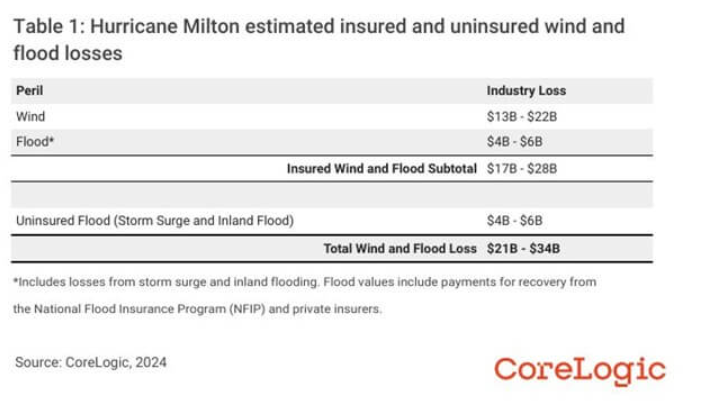CoreLogic has announced initial residential and commercial wind and flood loss estimates for Hurricane Milton. According to the initial data analysis, CoreLogic estimates that industry-wide insured wind and flood losses from Hurricane Milton are expected to be between $17 billion and $28 billion, and that total amount of damage, including losses to uninsured property, will be between $21 billion and $34 billion.
An assessment of the Hurricane Milton damage indicates that the majority of losses, $13 billion to $22 billion, will be from wind, which will account for the bulk of the privately insured losses. Coastal flood losses are expected to be highest in Sarasota and areas to the south such as Naples and Ft. Meyers. This is coupled with precipitation-induced inland flood losses, which are expected primarily in the Tampa Bay area. The combined flood losses will account for $4 billion to $6 billion of the insured loss total. These losses include damage to buildings, contents, and business interruption for onshore residential, commercial, and industrial property. The flood losses include damage from both storm surge and precipitation-induced inland flooding. This estimate does not include damage to offshore property such as inland marine, ocean-going marine cargo and hull, and personal boats. Insured flood losses include those covered by the private flood insurance markets and the National Flood Insurance Program (NFIP). The losses do not include damage from the associated tornado outbreak.

“Hurricane Milton was an unusual storm, causing unexpected wind and flood conditions across the state of Florida. As Hurricane Milton neared landfall, it interacted with the jet stream over the southeastern U.S. causing the winds on the northern and northwestern sides of the hurricane–generally known to be weaker–to be atypically strong,” explained Dr. Daniel Betten, Director of Forensic Meteorology at CoreLogic. “To add to the complexity, weather gauges in coastal Florida also measured hurricane force winds over Sarasota south of where Milton made landfall, essentially creating two distinct lanes of damaging, hurricane-force winds.”
One-Two Punch of Storms
According to the Florida Department of Law Enforcement, at least 24 people have died in connection with Hurricane Milton’s statewide destruction and flooding. This loss of life was compounded by the wrath inflicted by Hurricane Helene, which slammed into the Sunshine State just two weeks earlier, causing 27 deaths in Florida, and at least 228 altogether in Florida, Georgia, South Carolina, North Carolina, Tennessee and Virginia.
In addition to the damage to housing and loss of life, Hurricane Milton’s devastation in Florida had a ripple effect on the broader U.S. economy, impacting jobs, travel, manufacturing, retail sales, and other factors. Approximately 3% of America’s gross domestic product (GDP) was directly in Hurricane Milton’s path, according to Ryan Sweet, Chief U.S. Economist for Oxford Economics.
CoreLogic’s Hazard HQ Command Central event response team traveled to Central Florida to inspect the damage along both the Gulf and Atlantic Coasts as well as across the peninsula.
“Given the large concentration of property in the Tampa Bay area, including older residential and high-value commercial structures, large insured losses were possible,” said Tom Larsen, Associate VP Hazard & Risk Management at CoreLogic. “However, what we are seeing is less than expected wind damage and very little storm surge flood damage, especially in the population centers of the Tampa Bay area.”
Widespread rainfall depths between 10 and 15 inches were measured with local maximum of approximately 19 inches in a 24-hour period in St. Petersburg.
While Hurricane Helene made landfall over the Big Bend region of the Florida coastline miles from Tampa Bay, there will be some overlap between the tropical storm force wind fields, storm surge, and inland flooding leading to difficult loss attribution between the two storms. The overlap of severe storm surge damage in the Tampa Bay area during Hurricane Helene and possible wind damage during Hurricane Milton creates a scenario where leakage into wind-only policies is possible.
Recovery in Progress
As the local cleanup and rebuild begins in the wake of both Hurricane Helene and Hurricane Milton, the Biden Administration has approved more than $1.8 billion in federal assistance for individuals and communities impacted by the storms. FEMA has deployed more than 4,400 personnel to the affected areas, working side by side with over 8,000 federal responders to support state and local governments in their recovery efforts.
Federal assistance for those affected by the hurricanes includes $597 million to support survivors with housing repairs, personal property replacement and other essential recovery efforts. Additionally, over $934 million has been approved for debris removal and emergency protective measures, which are necessary to save lives, protect public health and prevent further damage to public and private property.





